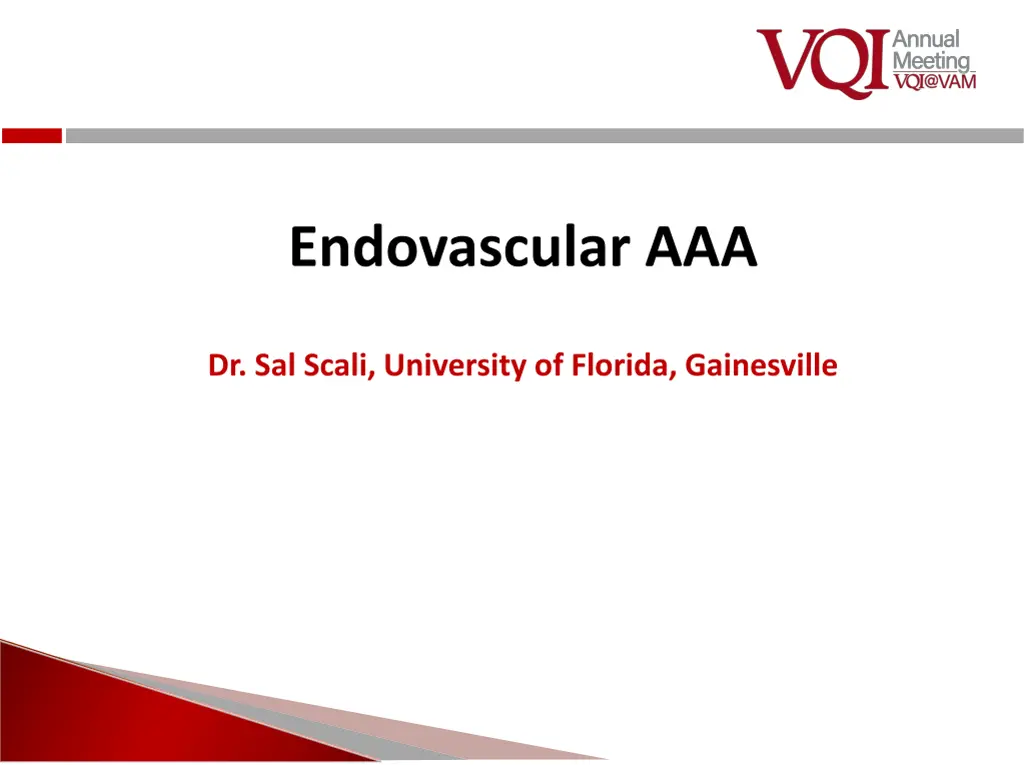
Endovascular AAA Case Review and Discussion with Dr. Sal Scali at University of Florida
Explore endovascular AAA case reviews and discussions led by Dr. Sal Scali at the University of Florida, covering topics like fluoroscopy time, intraoperative endoleaks, and project limitations. Join the session to enhance your knowledge in this medical field.
Uploaded on | 0 Views
Download Presentation

Please find below an Image/Link to download the presentation.
The content on the website is provided AS IS for your information and personal use only. It may not be sold, licensed, or shared on other websites without obtaining consent from the author. If you encounter any issues during the download, it is possible that the publisher has removed the file from their server.
You are allowed to download the files provided on this website for personal or commercial use, subject to the condition that they are used lawfully. All files are the property of their respective owners.
The content on the website is provided AS IS for your information and personal use only. It may not be sold, licensed, or shared on other websites without obtaining consent from the author.
E N D
Presentation Transcript
Endovascular AAA Dr. Sal Scali, University of Florida, Gainesville
Agenda: De-identified case review IRR variable variation discussion General Q & A for EVAR
Limitations of the IRR project: Independent audit: Please do not ask for any help from anyone (i.e. other data abstractors/physicians/etc). No dates included Instructed if they could not find a data element, it was ok to leave it blank and submit without validation
Q1: Fluoroscopy Time Total fluoroscopy time during the index procedure. Min/max range: 1 to 300 minutes
Select A1: Fluoroscopy Time a. 4.5 b. 40 c. 40.3 d. 40.32 e. 40.5 f. 40.53 g. 41 h. Other i. Unknown (leave blank)
A1: Fluoroscopy Time a. 4.5 b. 40 c. 40.3 d. 40.32 e. 40.5 f. 40.53 g. 41 h. Other i. Unknown (leave blank)
Q2: Intra Op Endoleak Any Intraoperative Endoleak Proximal(Ia) = Proximal attachment site [type Ia]; Distal Right (Ib) = Distal attachment site right iliac [type Ib]; Distal Left (Ib) = Distal attachment site left iliac [type Ib]; Lumbar Branch (II) = Lumbar branch [type II] retrograde filling of sac via lumbar artery; IMA Branch (II) = IMA branch [type II] retrograde filling of sac via inferior mesenteric artery; Accessory Renal Branch (II) = Accessory renal branch [type II] retrograde filling of sac via accessory renal artery; Mid Graft Separation (III) = Mid-graft separation [type III] = Filling of sac via leak at limb overlap sites or limb separation; Midgraft Fabric Hole = Mid-graft fabric hole [type III] = Filling of sac via hole in graft fabric; Indeterminate = Endoleak seen but type is not certain.
Select A2: Intra Op Endoleak a. No b. Yes c. Unknown (leave blank)
A2: Intra Op Endoleak a. No b. Yes c. Unknown (leave blank)
Q3: Ejection Fraction Most recent left ventricular ejection fraction (%), by Echo, nuclear scan, or cath estimate, within 6 months; If none within 6 months, choose not done; Choose unknown if it is not known whether a test was done, or if the result cannot be determined
Select A3: Ejection Fraction a. <30% b. 30-50% c. >50% d. Not Done e. Unknown f. (leave blank)
A3: Ejection Fraction a. <30% b. 30-50% c. >50% d. Not Done e. Unknown f. (leave blank)
Q4: Unfit for Open Repair Endovascular repair performed because patient was considered too high risk by surgeon for open repair, i.e., mandatory endovascular repair
Select A4: Unfit for Open Repair a. No b. Yes c. Unknown (leave blank)
A4: Unfit for Open Repair a. No b. Yes c. Unknown (leave blank)
Q5: Reason Unfit for Open List reasons the surgeon considered the patient unfit for open surgery This field is required if Unfit for Open AAA Repair is [Yes]
Select A5: Reason Unfit for Open a. Cardiac b. Pulmonary c. Frailty d. Hostile Abdomen e. Not Unfit for Open (so question not asked)
Select A5: Reason Unfit for Open a. Cardiac b. Pulmonary c. Frailty d. Hostile Abdomen e. Not Unfit for Open (so question not asked)
Q6: Iliac Aneurysm Aneurysm defined as Iliac diameter at least 2.0 cm
Select A6: Iliac Aneurysm a. No b. Right c. Left d. Bilateral e. Unknown (leave blank)
A6: Iliac Aneurysm a. No b. Right c. Left d. Bilateral e. Unknown (leave blank)
Q7: Left Iliac Adjunct Adjunctive procedure performed to facilitate delivery of the endovascular devices
Select A7: Left Iliac Adjunct a. None b. PTA c. Stent d. Stent Graft e. Other f. Unknown (leave blank)
A7: Left Iliac Adjunct a. None b. PTA c. Stent d. Stent Graft e. Other f. Unknown (leave blank)
Q8: Max AAA Diameter Use max diameter measured at right angle to centerline. If not possible, use max AP diameter. If multiple imaging modalities, use most accurate in following hierarchy: CT>MRI>Ultrasound>arteriogram Min/max range: 20 to 150 mm
Select A8: Max AAA Diameter a. 52 b. 57 c. Other d. Unknown (leave blank)
A8: Max AAA Diameter a. 52 b. 57 c. Other d. Unknown (leave blank)
Q9: Aortic Neck Angle Maximum angle between axis of suprarenal aorta and aneurysm neck, optimally measured with 3-D CT imaging software
Select A9: Aortic Neck Angle a. < 45 Degrees b. 45-60 Degrees c. 61-75 Degrees d. 76-90 Degrees e. 90 Degrees f. Unknown (leave blank)
A9: Aortic Neck Angle a. < 45 Degrees b. 45-60 Degrees c. 61-75 Degrees d. 76-90 Degrees e. 90 Degrees f. Unknown (leave blank)
